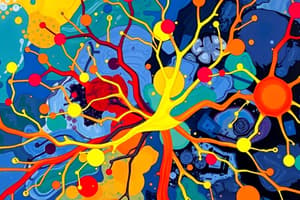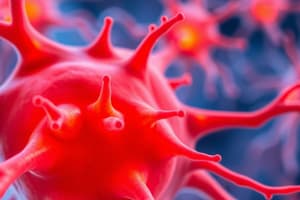Podcast
Questions and Answers
What role do calcium ions (Ca++) play in synaptic transmission?
What role do calcium ions (Ca++) play in synaptic transmission?
- They bind with protein receptors causing neurotransmitter release. (correct)
- They cause depolarization in the post-synaptic terminal.
- They are involved in the reuptake of neurotransmitters.
- They inhibit neurotransmitter release.
Which structure is responsible for the release of neurotransmitters into the synaptic cleft?
Which structure is responsible for the release of neurotransmitters into the synaptic cleft?
- Pre-synaptic membrane (correct)
- Voltage-gated sodium channels
- Post-synaptic neuron
- Synaptic vesicles
What is the primary role of synapses in the nervous system?
What is the primary role of synapses in the nervous system?
- They generate action potentials.
- They provide structural support to neurons.
- They integrate and process information. (correct)
- They produce neurotransmitters.
What happens during depolarization of the pre-synaptic terminal?
What happens during depolarization of the pre-synaptic terminal?
How do synapses influence weak signals in the nervous system?
How do synapses influence weak signals in the nervous system?
What is the primary function of synaptic vesicles?
What is the primary function of synaptic vesicles?
What type of synapse primarily transmits signals through neurotransmitter substances?
What type of synapse primarily transmits signals through neurotransmitter substances?
Which type of signals can modulate synaptic transmission?
Which type of signals can modulate synaptic transmission?
When a person touches a hot stove, what is the immediate response facilitated by the nervous system?
When a person touches a hot stove, what is the immediate response facilitated by the nervous system?
What characterizes synaptic clefts?
What characterizes synaptic clefts?
Which component of the neuron has binding components for neurotransmitter receptors?
Which component of the neuron has binding components for neurotransmitter receptors?
What defines the junction point between two neurons?
What defines the junction point between two neurons?
How do excitatory and inhibitory signals affect synaptic transmission?
How do excitatory and inhibitory signals affect synaptic transmission?
What is the process called where signals may be channeled in multiple directions?
What is the process called where signals may be channeled in multiple directions?
What do synapses determine regarding the flow of nervous signals?
What do synapses determine regarding the flow of nervous signals?
What structure is crucial for the transmission of signals in chemical synapses?
What structure is crucial for the transmission of signals in chemical synapses?
What is the primary function of chemically activated ion channels in neurons?
What is the primary function of chemically activated ion channels in neurons?
How does the Na-K pump affect the resting membrane potential (RMP) of neurons?
How does the Na-K pump affect the resting membrane potential (RMP) of neurons?
What is the Nernst potential for Na+ in this context?
What is the Nernst potential for Na+ in this context?
What effect does an increase in the number of receptors have in synaptic transmission?
What effect does an increase in the number of receptors have in synaptic transmission?
What is the primary role of inhibitory Cl- channels in neurons?
What is the primary role of inhibitory Cl- channels in neurons?
What characterizes the distribution of potentials in the soma during electrical events?
What characterizes the distribution of potentials in the soma during electrical events?
Which statement best describes the role of second messengers in neuronal signaling?
Which statement best describes the role of second messengers in neuronal signaling?
What is the concentration difference for K+ across the neuronal membrane as stated?
What is the concentration difference for K+ across the neuronal membrane as stated?
Study Notes
Synapses and Signal Transmission
- Synapses vary in efficiency, with some transmitting signals easily while others do so with difficulty.
- Facilitatory and inhibitory signals influence synaptic transmission, either enhancing or blocking signal flow.
Mechanism of Action Potential
- Action potentials in presynaptic terminals cause depolarization.
- Influx of sodium (Na+) and calcium (Ca++) ions leads to neurotransmitter release.
- Calcium ions bind to protein receptors, triggering exocytosis of neurotransmitters into the synaptic cleft.
Components of a Synapse
- Presynaptic Terminals: Contain synaptic vesicles with neurotransmitters, mitochondria for ATP, and voltage-gated calcium channels.
- Synaptic Cleft: Approximately 200-300 Å wide, the gap where neurotransmitters travel.
- Postsynaptic Neuron: Contains two main receptor protein components—binding and channel components, crucial for signal processing.
Integrative Function of Synapses
- Synapses selectively block weak signals while allowing stronger signals to pass.
- They may amplify certain weak signals and channel them in multiple directions.
- Example: Quick withdrawal from a hot surface stimulates both local and body-wide responses.
Types of Synapses
- Chemical Synapses: Majority of CNS synapses use neurotransmitter substances for signal transmission.
- Ion Channels: Two main types include excitatory Na+ channels and inhibitory K+ and Cl- channels.
- Enzymatic functions manifest in receptor dynamics—whether increasing or decreasing receptor numbers.
Resting Membrane Potential (RMP)
- RMP creates a negative interior in the neuronal soma due to the Na-K pump, which extrudes 3 Na+ for every 2 K+ ion transported inward.
- Charged ions, such as protein ions and phosphate compounds, contribute to the negativity within the soma, preventing outward diffusion.
Distribution of Electrical Charge
- A uniform distribution of potential exists within the soma; any change in potential affects intrasomal fluid uniformly.
- High conductivity within the soma aids in efficient electrical current conduction due to its large diameter and electrolyte nature.
Excitatory Postsynaptic Potential (EPSP)
- Key to understanding synaptic functions and how positive changes in membrane potential can lead to neuron activation.
Studying That Suits You
Use AI to generate personalized quizzes and flashcards to suit your learning preferences.
Related Documents
Description
Explore the complex world of synapses and their role in signal transmission in the nervous system. This quiz covers key concepts such as action potentials, neurotransmitter release, and the components of a synapse. Test your understanding of these fundamental mechanisms in neuroscience.




